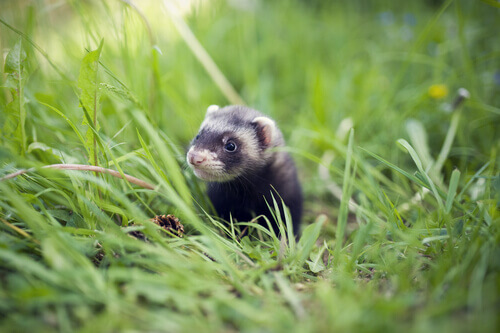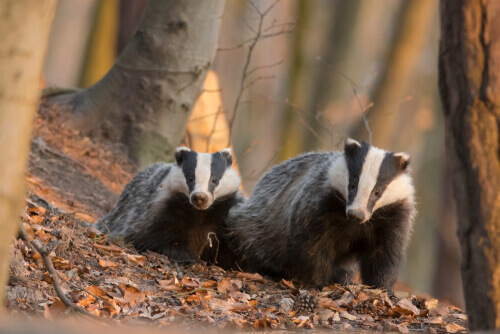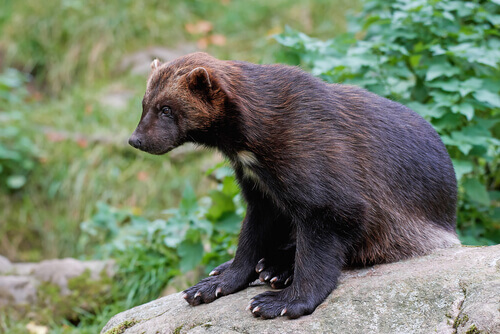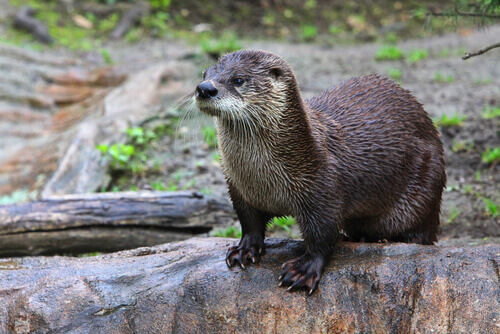What Are Mustelids?

Mustelids are a very large family of animals who, although they’re similar, have very varied habits. Did you know that ferrets and otters are related? And that there’s a species of mustelid that fights with bears? Read on to find out more.
General characteristics of mustelids
The mustelid family includes a variety of mammalian animals, and they have more characteristics in common than differences. Their diet, for example, as they’re all carnivores. Some are active hunters and others prefer to be scavengers, but none are herbivores or omnivores.
Mustelids’ bodies are all similar too: they have short legs and an elongated body. They have an abundance of lustrous hair, usually in brown or brownish shades. In addition they all have a long, fat snout and small, rounded ears.
They have scent glands that they use to ward off threats or to communicate with each other. All have five toes and walk with only their toes. They also have sharp claws and these aren’t retractable.
Mustelids live all over the world, except in Antarctica and Australia. They can live in very different ecosystems: there are mustelids which are adapted to forests and to snow and there are several types of aquatic mustelids. Some live on river banks, while others are more dependent on the ocean.
Domestic mustelids
The ferret is one of the best-known mustelids due to it being a domestic animal. They’re small to medium-sized: they weigh between one and four pounds, and are around twenty inches long. Most ferrets are brown with a lighter-colored face, while their legs are black. There are also white ferrets.
They’re carnivores, and pet ferrets usually feed on cat food, although there are also specific feeds and snacks for ferrets. They have crepuscular habits and, when they’re not sleeping, they’re very active and curious animals.
Wild mustelids
Most mustelids are wild. They’re spread over almost the entire planet and there are many different species, so these are just a few examples:
The common weasel has a very extensive habitat and can be found in Europe, Asia, North America and even North Africa. It’s one of the smallest species of its family, with some weighing barely seven ounces.

Badgers, on the other hand, are quite large. These black and white striped animals live in Europe, although they’re also widespread in the Arabian Peninsula. They weigh between 22 and 28 pounds and are nocturnal. They’re sociable among their own kind: they live in groups, play a lot with each other and even collaborate in grooming each other.
Stoats are adapted to life in cold areas: they’re widespread in northern Europe and Asia, as well as throughout Canada and Alaska. During the winter, their fur is white and, when the thaw arrives, it turns brown: this is how they camouflage themselves against the color of the ground. They’re very small, weighing only ten ounces.
Wolverines are the largest terrestrial mustelids in existence. They can reach three feet in length and weigh almost 45 pounds. Their appearance is more reminiscent of a bear than a mustelid, although if you look closely, the similarities with the rest of their family are obvious.

They can be found in the colder areas of the northern hemisphere: the boreal forests of Europe, Asia and America, as well as the alpine tundra. They’re constantly looking for prey to hunt, both day and night. And, although they’re hunters, they’re also scavengers, and have been seen chasing bears away from animal carcasses in order to feed.
Aquatic mustelids
A few animals in this family live in aquatic or mixed habitats. Otters are one example; they live in both rivers and seas and need the presence of water to survive.

The best known of this species is the river otter. They weigh around 24 pounds and live in almost all of Europe and Asia, as well as North Africa. They have a very varied diet, feeding on crustaceans, frogs and fish.
However, the largest mustelid of all lives in South America: the giant otter. This otter can be over six feet long and weigh up to 90 pounds. They live around the Amazon River, form small social groups and have diurnal habits.
Mustelids are mammals that vary greatly in size, but not so much in color: they’re almost all brownish in color, with short legs and five toes. They have small, rounded ears, and can live on land, in rivers or in the mountains.
All cited sources were thoroughly reviewed by our team to ensure their quality, reliability, currency, and validity. The bibliography of this article was considered reliable and of academic or scientific accuracy.
- Koepfli, K. P., Deere, K. A., Slater, G. J., Begg, C., Begg, K., Grassman, L., … & Wayne, R. K. (2008). Multigene phylogeny of the Mustelidae: resolving relationships, tempo and biogeographic history of a mammalian adaptive radiation. BMC biology, 6(1), 1-22.
- Johnson, D. D., MacDonald, D. W., & Dickman, A. J. (2000). An analysis and review of models of the sociobiology of the Mustelidae. Mammal Review, 30(3‐4), 171-196.
- Sommer, R., & Benecke, N. (2004). Late‐and Post‐Glacial history of the Mustelidae in Europe. Mammal Review, 34(4), 249-284.